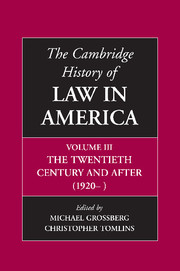Book contents
- Frontmatter
- 1 Law and the State, 1920–2000: Institutional Growth and Structural Change
- 2 Legal Theory And Legal Education, 1920–2000
- 3 The American Legal Profession, 1870–2000
- 4 The Courts, Federalism, and The Federal Constitution, 1920–2000
- 5 The Litigation Revolution
- 6 Criminal Justice in the United States
- 7 Law and Medicine
- 8 The Great Depression and the New Deal
- 9 Labor’s Welfare State: Defining Workers, Constructing Citizens
- 10 Poverty law and income Support: From the Progressive Era to the War on Welfare
- 11 The Rights Revolution in the Twentieth Century
- 12 Race and Rights
- 13 Heterosexuality as a Legal Regime
- 14 Law and the Environment
- 15 Agriculture and the State, 1789–2000
- 16 Law and Economic Change During the Short Twentieth Century
- 17 The Corporate Economy: Ideologies of Regulation and Antitrust, 1920–2000
- 18 Law and Commercial Popular Culture in the Twentieth-Century United States
- 19 Making Law, Making War, Making America
- 20 Law, Lawyers, and Empire
- Bibliographic Essays
- Notes on Contributors
- Index
- References
7 - Law and Medicine
Published online by Cambridge University Press: 28 November 2008
- Frontmatter
- 1 Law and the State, 1920–2000: Institutional Growth and Structural Change
- 2 Legal Theory And Legal Education, 1920–2000
- 3 The American Legal Profession, 1870–2000
- 4 The Courts, Federalism, and The Federal Constitution, 1920–2000
- 5 The Litigation Revolution
- 6 Criminal Justice in the United States
- 7 Law and Medicine
- 8 The Great Depression and the New Deal
- 9 Labor’s Welfare State: Defining Workers, Constructing Citizens
- 10 Poverty law and income Support: From the Progressive Era to the War on Welfare
- 11 The Rights Revolution in the Twentieth Century
- 12 Race and Rights
- 13 Heterosexuality as a Legal Regime
- 14 Law and the Environment
- 15 Agriculture and the State, 1789–2000
- 16 Law and Economic Change During the Short Twentieth Century
- 17 The Corporate Economy: Ideologies of Regulation and Antitrust, 1920–2000
- 18 Law and Commercial Popular Culture in the Twentieth-Century United States
- 19 Making Law, Making War, Making America
- 20 Law, Lawyers, and Empire
- Bibliographic Essays
- Notes on Contributors
- Index
- References
Summary
Both law and medicine possess considerable social significance and power. The two professions and their institutions, practices, and ethics speak to and engage each other continuously. Interestingly, however, “law and medicine” is an underdeveloped field of history. No doubt the relative inattention that law and medicine have received from historians is related to the way in which the fields of legal history and medical history initially developed. Both grew out of the professions themselves and within law and medical schools, each producing an emphasis on a single profession, its interests, activities, and heroes. Medical jurisprudence, a specialized product of two professions with specialized knowledge and practitioners, provided a point of intersection. The history of medical jurisprudence includes the intellectual relationship between the legal and medical professions around specific scientific and medical questions that arose in the legal arena, as well as the professional relationship between physicians and attorneys (especially regarding malpractice). Yet, the traditional subjects of medical jurisprudence are only part of the history of medicine, law, and society.
Here, rather than sticking to a narrow formulation of the legal history of medicine focused on medical jurisprudence, I expand the definition of the field and recast it to include public health, health-related legislation, and the regulatory apparatuses of administrative law. An enlarged field of analysis allows us to examine public health and its relationship to the state and to criminal law and then to take those insights and look again at individual medical practices. Analysis across areas of law and medicine typically thought of as separate makes visible links that are otherwise concealed and presumed nonexistent.
- Type
- Chapter
- Information
- The Cambridge History of Law in America , pp. 232 - 267Publisher: Cambridge University PressPrint publication year: 2008



